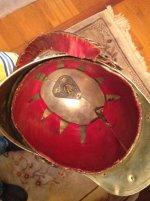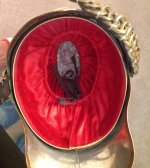Yeohelmetguy
Well-known member
This post, number 9, highlights another helmet from my collection belonging to a very small, short lived (approximately twenty-two months) and obscure unit in the Volunteer force of the British Army. This 1847 pattern helmet is to an officer of the Lancashire Mounted Rifle Volunteers. The unit was only in existence for less than two years and at its height of enrollment never numbered more than three officers and approximately fifty troopers on its rolls. There are only two known examples of helmets to this unit known to exist today, my officer's helmet and another helmet that was sold at auction some years ago by Garth Vincent Auctioneers. I do not know if that helmet was a trooper's helmet or officer's helmet.
The excerpt include herein is from an article written by H. Y. Usher, Helmets of the Lancashire Mounted Rifle Volunteers and the 1st Lancashire Light Horse Volunteers that was published in the December 1958 (Volume 36, number 148) edition of The Journal of the Society for Historical Army Research.
"The monthly Army List for June 1860. and January 1861 show a unit known as the 1st Lancashire Mounted Rifle Volunteers with headquarters at Manchester and with three officers, Captain H. A. Bennett, Lieutenant P. Turner, and Ensign S. P. Callender, all of whose commission were dated 22nd March 1860. Ensign Callendar’s name does not appear in the January,1861 list and had presumably he had resigned before that date. By the monthly list of November,1861 the unit had ceased to exist. No other unit of this name can be traced from the lists available to me."
"The officer’s helmet of this unit, must, indeed be rare, for Bennett and Turner subsequently carried on in the Lancashire Light Horse Volunteers, and it is possible that they may have had only the badge on their original helmets changed. The helmet is all silver plated except for the gilt rose boss atop the plume. The central device on the badge is a silver beaded star with thirty-four points or rays. On it is a garter with a “matt” surface and raised title letters reading MOUNTED RIFLE VOLUNTEERS. The garter surrounds a plain ground on which are embossed the Arms of the County Palatine of Lancaster, viz., the three lions with the cadence mark of a label with three points on the upper one. The horsehair plume is white over red, the stem being a red “shaving brush” shape. The helmet and chain are lined with fine red leather…"
Reference to this helmet can also be found in David J. J. Rowe's definitive work on British dragoon helmets titled Head Dress of the British Heavy Cavalry, Dragoon Guards, Household and Yeomanry Cavalry 1842-1934, pages 152-153.
Comments are always welcome, and as always, I appreciate you taking the time to view the helmet in this post and read the brief history of this unit! I hope you continue to view the helmets in my collection!
Cheers.
David
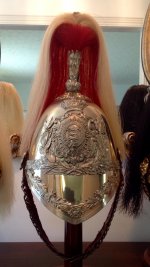
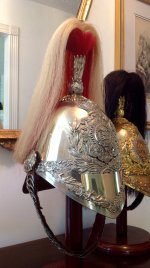
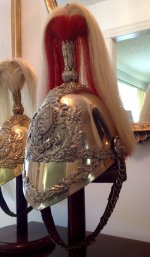
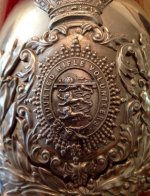
The excerpt include herein is from an article written by H. Y. Usher, Helmets of the Lancashire Mounted Rifle Volunteers and the 1st Lancashire Light Horse Volunteers that was published in the December 1958 (Volume 36, number 148) edition of The Journal of the Society for Historical Army Research.
"The monthly Army List for June 1860. and January 1861 show a unit known as the 1st Lancashire Mounted Rifle Volunteers with headquarters at Manchester and with three officers, Captain H. A. Bennett, Lieutenant P. Turner, and Ensign S. P. Callender, all of whose commission were dated 22nd March 1860. Ensign Callendar’s name does not appear in the January,1861 list and had presumably he had resigned before that date. By the monthly list of November,1861 the unit had ceased to exist. No other unit of this name can be traced from the lists available to me."
"The officer’s helmet of this unit, must, indeed be rare, for Bennett and Turner subsequently carried on in the Lancashire Light Horse Volunteers, and it is possible that they may have had only the badge on their original helmets changed. The helmet is all silver plated except for the gilt rose boss atop the plume. The central device on the badge is a silver beaded star with thirty-four points or rays. On it is a garter with a “matt” surface and raised title letters reading MOUNTED RIFLE VOLUNTEERS. The garter surrounds a plain ground on which are embossed the Arms of the County Palatine of Lancaster, viz., the three lions with the cadence mark of a label with three points on the upper one. The horsehair plume is white over red, the stem being a red “shaving brush” shape. The helmet and chain are lined with fine red leather…"
Reference to this helmet can also be found in David J. J. Rowe's definitive work on British dragoon helmets titled Head Dress of the British Heavy Cavalry, Dragoon Guards, Household and Yeomanry Cavalry 1842-1934, pages 152-153.
Comments are always welcome, and as always, I appreciate you taking the time to view the helmet in this post and read the brief history of this unit! I hope you continue to view the helmets in my collection!
Cheers.
David





